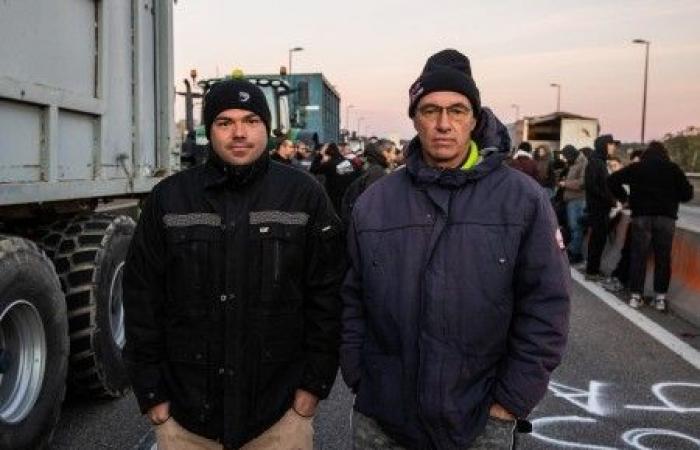« Agri, act 2. We're back. AND–FDSEA ». The large black sign, hung on a tractor on the Peace roundabout in Cannet-des-Maures (Var), on November 18, offered a good summary of the situation. According to the authorities, 6,836 farmers with 1,898 agricultural machines were mobilized that day, at the call of the FNSEAthe majority and productivist union, and Young Farmers (AND).
« It's been a long time since we've seen this much anticipation and heat on the field. We can clearly see that the Barnier government is not going fast enough and far enough »observed the president of Young Farmers, Pierrick Horel. The movement will continue « until mid-December »warned the president of the majority union. With three demands: the abandonment of the proposed free trade agreement between the European Union (UE) and the Mercosur countries, the cessation of environmental constraints, and agricultural prices and incomes.
Read also: Why are farmers remobilizing?
It may seem surprising that the FNSEA relaunch of demonstrations and carries a message of firmness, in view of the concessions already obtained. Put under pressure by last winter's mobilizations, Gabriel Attal's government committed to 70 measures to support productivist, intensive and mechanized export-oriented agriculture, corresponding to the main demands of the majority union. Many of them were also included in the Entrepreneurship in Agriculture bill, presented at the end of August by the FNSEA and the AND.
Many have also already been implemented. The plan to increase non-road agricultural diesel was abandoned. The Écophyto plan aimed at reducing the use of pesticides has been equipped with a new, less ambitious indicator. A hydraulic fund with 20 million euros has been created, accompanied by an initial call for projects for the creation of water reservoirs for irrigation and a decree facilitating their installation in wetlands. A decree relaxes environmental assessment rules for intensive poultry, pig and sow farms.
According to the Ministry of Agriculture, 67 % of these measures had already been implemented as of September 13. Moreover, it is the pace of implementation that the FNSEAmuch more than the measures conceded. « 65 % of the announced measures have still not arrived in farmyards »deplored the union in a press release dated November 17.
Close ties with the state
The FNSEAcreated in 1946, quickly became co-manager of French agriculture. The modernization laws of 1960 and 1962 « were co-developed between public authorities and trade unions »explained to Monde Véronique Lucas, rural sociologist at the Research Institute for Agriculture, Food and the Environment (INRAE).
Even today, the FNSEA is present in numerous parapublic organizations, controls almost all chambers of agriculture and a large part of the professional press. Some of its executives have extremely close links with the highest echelons of power, as revealed by the investigative media Splann ! last May. An emblematic example of this mixture of genres, the deputy of the Minister of Agriculture Annie Genevard, Éric Liégeon, who replaced her in the National Assembly, was secretary general and vice-president of the FDSEA of the Doubs.
Hence this paradoxical position — consultation with those in power on the one hand, support and encouragement for grassroots mobilizations on the other. The union holds this crest line « since the late 1950s »explains agricultural historian Anthony Hamon. « The central Parisian leadership has always been opposed to demonstrations and the associated folklore — road blockages, damage, etc. But it is haunted by the risk of union separatism, if it did not follow the departmental federations and the field »he explains. It is therefore a question of maintaining one's position as the privileged interlocutor of power, while not losing the link with the field to avoid being overwhelmed by the base.
Farmers sow cereals threatened with extinction in front of the ramparts of Avignon, November 18, 2024.
© David Richard/Reporterre
However, the exercise is becoming more and more complex. There FNSEA boasts 212,000 members and 31 producer federations. But its hegemony is eroding. During the 2019 Chamber of Agriculture elections, marked by a record abstention level of 54 %, it was necessary to join forces with Young Farmers to reach 55 % of votes cast. « This is because the productivist measures it takes only benefit a minority of farmersanalyse Anthony Hamon. The majority, less rich, less advantaged, who are not present in the decision-making bodies of cooperatives, do not see the color of the public aid obtained. »
The president of the FNSEA since 2023, Arnaud Rousseau has in fact had an unusual profile, not so representative of most farmers: head of a cereal farm of more than 700 hectares, he chairs the board of directors of the agro-industrial group Avril.
The next elections for the Chambers of Agriculture, on January 31, will be decisive for the majority union, threatened by the rise of Rural Coordination. « Hence the demagogic escalation on the part of the FNSEA »explains Anthony Hamon.
legend







